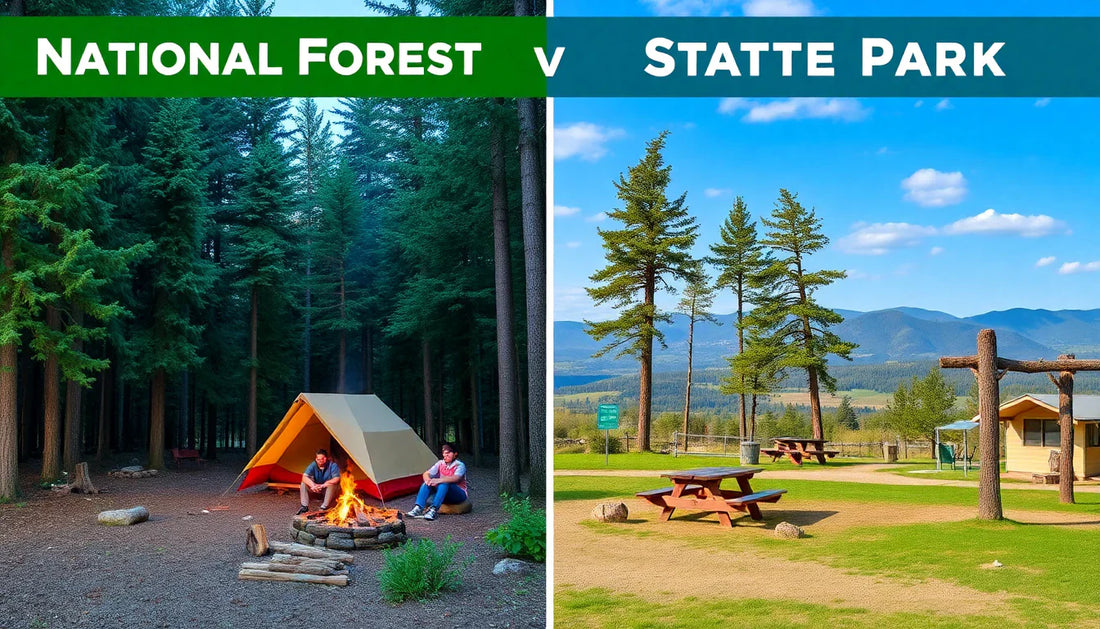
Camping in National Forests vs State Parks: What's the Difference?
Share
As the crisp autumn air settles in and the leaves begin to change, the call of the great outdoors beckons. For many outdoor enthusiasts, this time of year marks the perfect opportunity to plan their next camping adventure. However, with a vast array of camping options across the United States, from national forests to state parks, it can be challenging to determine the best fit for your needs.
In this comprehensive guide, we'll explore the key differences between camping in national forests and state parks, helping you make an informed decision and ensure your next camping trip is a resounding success.
National Forests: An Expansive Wilderness
National forests are vast, federally-managed lands that offer a unique and often more rugged camping experience. These expansive areas, managed by the U.S. Forest Service, are known for their diverse landscapes, ranging from towering mountains and dense forests to serene lakes and winding rivers.
One of the defining features of national forests is the availability of dispersed camping, which allows campers to set up their tents virtually anywhere within the forest, as long as they adhere to specific regulations. This freedom to roam and find the perfect secluded spot can be a major draw for those seeking a more remote and off-the-grid camping experience.
However, with this freedom comes a greater responsibility to be self-sufficient and knowledgeable about the area. Campers in national forests must be prepared to pack in and pack out all their supplies, as well as follow strict guidelines regarding campfires, waste management, and wildlife interactions.
State Parks: Curated Camping Experiences
In contrast, state parks offer a more structured and amenity-rich camping experience. These parks, managed by individual state governments, often feature well-maintained campgrounds with a range of facilities, from electrical hookups and running water to picnic areas and hiking trails.
One of the primary advantages of state park camping is the level of infrastructure and services available. Campers can typically expect to find designated campsites, often with picnic tables, fire pits, and access to restrooms and showers. This level of comfort and convenience can be particularly appealing for families, first-time campers, or those seeking a more relaxed and hassle-free outdoor experience.
Additionally, state parks often have a strong focus on recreational activities, with a wide range of amenities and programs designed to enhance the camping experience. From swimming beaches and boat rentals to interpretive nature trails and ranger-led activities, state parks offer a more curated and immersive outdoor experience.
Key Differences: Cost, Amenities, and Regulations
When it comes to the practical considerations of camping, there are several key differences between national forests and state parks that are worth noting:
Cost
Camping in national forests is generally more affordable, with many areas offering free or low-cost dispersed camping options. In contrast, state park campsites often come with a fee, which can vary depending on the location and amenities provided.
Amenities and Infrastructure
As mentioned earlier, state parks typically offer a higher level of amenities and infrastructure, including developed campgrounds, electrical hookups, running water, and modern restroom facilities. National forests, on the other hand, tend to have more basic or even primitive camping options, with a focus on a more rugged and self-reliant experience.
Regulations and Restrictions
National forests generally have fewer restrictions on camping, with the ability to set up camp in designated areas or practice dispersed camping. State parks, however, often have more stringent regulations, such as designated campsites, limits on group size, and restrictions on campfires and other activities.
Pros and Cons of National Forest Camping
Advantages
- Affordable or free camping options
- Opportunities for remote and secluded camping experiences
- Diverse natural landscapes and ecosystems to explore
- Greater freedom and flexibility in choosing a campsite
Potential Challenges
- Lack of developed amenities and infrastructure
- Increased responsibility for self-sufficiency and Leave No Trace principles
- Potential for encountering wildlife and navigating remote terrain
- Limited access to services and supplies
Pros and Cons of State Park Camping
Advantages
- Well-maintained campgrounds with modern amenities
- Variety of recreational activities and programs
- Easier access to supplies and services
- Suitable for families and first-time campers
Potential Challenges
- Higher camping fees and costs
- More restrictive regulations and limited flexibility in campsite selection
- Potentially more crowded and less secluded camping experiences
Choosing the Right Camping Location
When deciding between national forests and state parks for your next camping adventure, it's essential to consider your personal preferences, camping style, and the specific needs of your group.
If you're seeking a more rugged, self-reliant, and budget-friendly experience, national forests may be the ideal choice. However, if you prefer the convenience of developed amenities, organized recreational activities, and a more structured camping environment, state parks may be the better fit.
Additionally, factors such as the season, your level of camping experience, and the presence of children or pets can all play a role in determining the most suitable camping location.
Conclusion
Whether you're a seasoned camper or a newcomer to the great outdoors, understanding the differences between national forests and state parks can help you make an informed decision and ensure your next camping trip is a memorable and enjoyable experience.
By weighing the pros and cons of each option and considering your personal preferences, you can find the perfect camping destination that aligns with your adventurous spirit and outdoor lifestyle. So pack your gear, lace up your boots, and get ready to explore the wonders of the great American wilderness, whether it's in a national forest or a state park.
